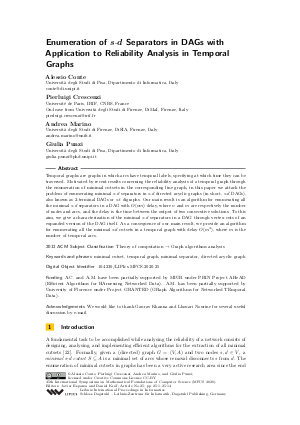@InProceedings{conte_et_al:LIPIcs.MFCS.2020.25,
author = {Conte, Alessio and Crescenzi, Pierluigi and Marino, Andrea and Punzi, Giulia},
title = {{Enumeration of s-d Separators in DAGs with Application to Reliability Analysis in Temporal Graphs}},
booktitle = {45th International Symposium on Mathematical Foundations of Computer Science (MFCS 2020)},
pages = {25:1--25:14},
series = {Leibniz International Proceedings in Informatics (LIPIcs)},
ISBN = {978-3-95977-159-7},
ISSN = {1868-8969},
year = {2020},
volume = {170},
editor = {Esparza, Javier and Kr\'{a}l', Daniel},
publisher = {Schloss Dagstuhl -- Leibniz-Zentrum f{\"u}r Informatik},
address = {Dagstuhl, Germany},
URL = {https://drops.dagstuhl.de/entities/document/10.4230/LIPIcs.MFCS.2020.25},
URN = {urn:nbn:de:0030-drops-126932},
doi = {10.4230/LIPIcs.MFCS.2020.25},
annote = {Keywords: minimal cutset, temporal graph, minimal separator, directed acyclic graph}
}

 Creative Commons Attribution 3.0 Unported license
Creative Commons Attribution 3.0 Unported license



























